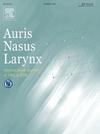侧咽成形术治疗阻塞性睡眠呼吸暂停综合征的回顾性研究。
IF 1.5
4区 医学
Q2 OTORHINOLARYNGOLOGY
引用次数: 0
摘要
目的:探讨侧咽成形术联合悬垂腭咽成形术治疗阻塞性睡眠呼吸暂停综合征的疗效及术后反应。方法:选取以咽环肥大或咽侧壁肥大为临床表现的127例阻塞性睡眠呼吸暂停综合征患者作为研究对象。其中病例组63例患者行咽成形术联合腭咽成形术(Uvulopalatopharyngoplasty, Uvulopalatopharyngoplasty, UPPP),对照组64例患者单独行UPPP。研究小组收集了多导睡眠图(PSG)和患者主观评价的客观数据,并对术前和术后6个月进行了统计比较。结果:两组患者平均年龄41.22±11.54岁(19 ~ 78岁),平均BMI为27.21±2.79kg/m2(21.22 ~ 34.99kg/m2)。术后病例组呼吸暂停低通气指数(AHI)由50.18±21.48下降至22.57±17.34,最低血氧饱和度(LSaO2)由(71.05±13.37)%上升至(75.98±10.76)%。与对照组的40.6%相比,病例组的成功率为74.6%。术后咽腔明显扩大,无严重并发症。结论:本研究中,咽外侧成形术与upppp联合治疗咽外侧壁肥大,可进一步提高手术效果,防止长期复发。术后症状可接受,无严重并发症报告。本文章由计算机程序翻译,如有差异,请以英文原文为准。
Retrospective study of lateral pharyngoplasty for the treatment of obstructive sleep apnoea syndrome
Objectives
To investigate the efficacy and postoperative reaction of lateral pharyngoplasty combined with Uvulopalatopharyngoplasty in patients with obstructive sleep apnoea syndrome.
Methods
A total of 127 obstructive sleep apnoea syndrome patients presenting with pharyngeal ring hypertrophy or lateral pharyngeal wall hypertrophy were included in this study. Among these, 63 patients in the case group underwent pharyngoplasty combined with Uvulopalatopharyngoplasty (UPPP), while 64 patients in the control group underwent UPPP alone. The team collected the objective data from polysomnography (PSG) and subjective patient evaluations and statistically compared preoperatively and six months postoperatively.
Results
In both groups, the mean age was 41.22±11.54years old (19–78 years), and the average BMI was 27.21±2.79kg/m2(21.22–34.99kg/m2). After surgery, the Apnea Hypopnea Index (AHI) in the case group decreased from 50.18±21.48 to 22.57±17.34, while the Lowest oxygen saturation (LSaO2) increased from (71.05±13.37) % to (75.98±10.76) %. The success rate was 74,6 % for the case group compared to 40.6 % for the control group. The pharyngeal cavity was significantly enlarged after the operation, with no serious complications reported.
Conclusions
In this study, lateral pharyngeal wall hypertrophy was treated by lateral pharyngoplasty concurrently with UPPP to enhance surgical outcomes further and prevent long-term recurrence. Postoperative symptoms were found to be acceptable, with no serious complications reported.
求助全文
通过发布文献求助,成功后即可免费获取论文全文。
去求助
来源期刊

Auris Nasus Larynx
医学-耳鼻喉科学
CiteScore
3.40
自引率
5.90%
发文量
169
审稿时长
30 days
期刊介绍:
The international journal Auris Nasus Larynx provides the opportunity for rapid, carefully reviewed publications concerning the fundamental and clinical aspects of otorhinolaryngology and related fields. This includes otology, neurotology, bronchoesophagology, laryngology, rhinology, allergology, head and neck medicine and oncologic surgery, maxillofacial and plastic surgery, audiology, speech science.
Original papers, short communications and original case reports can be submitted. Reviews on recent developments are invited regularly and Letters to the Editor commenting on papers or any aspect of Auris Nasus Larynx are welcomed.
Founded in 1973 and previously published by the Society for Promotion of International Otorhinolaryngology, the journal is now the official English-language journal of the Oto-Rhino-Laryngological Society of Japan, Inc. The aim of its new international Editorial Board is to make Auris Nasus Larynx an international forum for high quality research and clinical sciences.
 求助内容:
求助内容: 应助结果提醒方式:
应助结果提醒方式:


